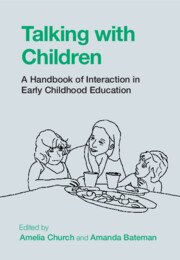Book contents
- Talking with Children
- Talking with Children
- Copyright page
- Dedication
- Contents
- Figures
- Tables
- Contributors
- Acknowledgements
- Notes on Transcription Conventions
- Introduction
- Part I Talk as Social Action
- Part II Pedagogy in Interaction
- 8 Literacy
- 9 Storytelling
- 10 Digital Technologies
- 11 Mathematics
- 12 Creativity
- 13 Multilingualism
- 14 Belonging
- Part III Interaction and Inclusion
- Index
- References
10 - Digital Technologies
from Part II - Pedagogy in Interaction
Published online by Cambridge University Press: 16 June 2022
- Talking with Children
- Talking with Children
- Copyright page
- Dedication
- Contents
- Figures
- Tables
- Contributors
- Acknowledgements
- Notes on Transcription Conventions
- Introduction
- Part I Talk as Social Action
- Part II Pedagogy in Interaction
- 8 Literacy
- 9 Storytelling
- 10 Digital Technologies
- 11 Mathematics
- 12 Creativity
- 13 Multilingualism
- 14 Belonging
- Part III Interaction and Inclusion
- Index
- References
Summary
This chapter starts with an overview of the research on young children’s storytelling both in the home and in preschool settings. It will then turn the reader’s attention to research concerned with the interactions of children aged from 1 year 11 months to 3 years in the home, collected in Australia. It aims to illustrate how storytelling in story book reading and in recounts is achieved and changes over time. The chapter ends with a discussion about practical implications for teachers.
Keywords
- Type
- Chapter
- Information
- Talking with ChildrenA Handbook of Interaction in Early Childhood Education, pp. 204 - 226Publisher: Cambridge University PressPrint publication year: 2022

